May 28, 2019

With grass slow to come this spring, it is likely that forage quality will rapidly change this summer. As a rule of thumb, energy values (total digestible nutrients or TDN) of forages, pasture included, can decrease rapidly at a rate of 0.33% to 1% per day from vegetative to mature stage. To preserve forage quality, harvesting excess forage acres in mid- to late May can be beneficial for later feeding.
The primary factor that influences quality of harvested forages is weather, says Erika Lundy, ISU Extension beef specialist. In many instances, a wet spring delays first-cutting harvest and reduces the window of opportunity for optimal drying days, resulting in mature hay that has reduced feed quality and palatability to beef cows. If hay wasn’t put up under the proper conditions, both storage and feeding losses will increase.
Management matters
To address some of the challenges associated with first-cutting forage crops, more producers have turned to harvesting forages as a baleage crop. While baleage production offers several advantages, it is an expensive investment and can result in poor return on investment if not done right.
Some considerations with baleage include proper timing of harvesting and storing of the forage, Lundy says. Target the bales to be 50% to 60% moisture. Generally, most baleage can be made within 24 hours of cutting and will need to be wrapped within 12 hours of baling.
Like corn silage, baleage put up too dry will slow fermentation and result in unwanted bacterial growth, mold or heat damage. If put up too wet, a cold fermentation may occur leading to “stinky” baleage from the presence of butyric acid, along with the degradation of proteins into some unfavorable metabolites and a slimy texture. These unwanted consequences will likely lead to compromised feed intake, reduced nutrient quality and, in some situations, animal health issues.
Tighter the better
Because plant sugar is a requirement for ensiling, using good-quality standing forage is best, Lundy says. Forage that has been rained on after cutting, as well as excessively mature standing forage will not optimize the ensiling process.
In addition, bale weight and forage density should be considered. Oxygen is the enemy when it comes to ensiling and too “loose” of a bale can lead to mold among other problems. Thus, the tighter the bale, the better. A minimum of 30 days is needed for the bales to fully ensile.
For more information on baleage considerations and what is best for your operation, consult with your ISU Extension beef specialist and read Making the switch to baleage, IBCR 202.
Source: ISU, which is responsible for information provided and is wholly owned by source. Informa Business Media and its subsidiaries aren’t responsible for any of the content contained in this information asset.
You May Also Like




